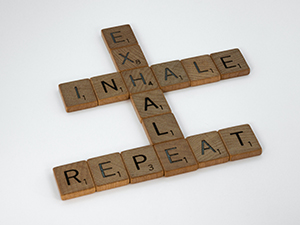
Stress and anxiety: the benefits of cardiac coherence
Even at rest, our heartbeat is not regular. This natural variation in heart rate from one beat to the next is called heart rate variability (or pulse) and is directly linked to the autonomic nervous system.

The heart is constantly subject to 2 opposing influences: the sympathetic nervous system (SNS) and the parasympathetic nervous system (SNP).
The sympathetic nervous system (SNS) speeds up the body: in the event of danger or fear, it activates noradrenaline and adrenaline to prepare the body for action (fight-flight).
The parasympathetic nervous system (PNS) slows the body down: once the threat has passed, it triggers a general slowdown of the body’s functions to help recovery.
Unfortunately, stress can sometimes upset this balance, altering the activation of the parasympathetic system or wrongly triggering the sympathetic system when you are trying to rest.
But the autonomic nervous system doesn’t just regulate heart rate and breathing.
It is also involved in digestion and the immune system. This can lead to insomnia, digestive problems, allergies and inflammation. There is, however, a simple way of countering the harmful effects of stress: cardiac coherence.
What is cardiac coherence?
Cardiac coherence involves regulating the autonomic nervous system by synchronising the activity of the sympathetic and parasympathetic systems through controlled breathing. The inhalation phase stimulates the SNS, while exhalation acts on the PNS. Here’s the impact on heart rate variability (“heart rate variability” diagram):

Who invented cardiac coherence?
Technically, no one invented cardiac coherence because it is a physiological state.
In the 90s, researchers at the HeartMath Institute in the United States discovered that cardiac activity affects brain function. They found that the signals sent by an irregular heartbeat (in the event of stress, for example) interfered with our ability to think clearly, memorise, learn and make effective decisions. Conversely, a stable heart rate has a positive effect on the way we perceive, think and act.
These discoveries reached France thanks to Dr David Servan-Shreiber, who first mentioned cardiac coherence in his book GUERIR le stress, l’anxiété et la dépression sans médicaments ni psychanalyse (“HEALING stress, anxiety and depression without drugs or psychoanalysis”) in 2003.
Other advocates of cardiac coherence include David O’Hare and his 365 method for :
3 times a day / 6 breaths a minute / for 5 minutes / 365 days of the year.
Finally, cardiac coherence is one of the practices recommended by the French Federation of Cardiology for managing stress.

What does cardiac coherence bring?
According to American researchers at the Heartmath Institute, “research shows that when we activate this state, our physiological systems function more efficiently, we experience greater emotional stability, and we also have increased mental clarity and improved cognitive function. Simply put, our bodies and brains function better, we feel better and we perform better.” (1)
The impact of cardiac coherence on the way our body functions has been clinically proven. Breathing with cardiac coherence leads to hormonal changes:
- reduced secretion of the stress hormone cortisol
- an increase in DHEA, the hormone involved in cell regeneration
- favourable action on dopamine, the pleasure hormone
- increase in oxytocin, the attachment hormone
- favourable effect on serotonin, an emotion regulator.
Cardiac coherence also has an impact on blood pressure, blood sugar levels, fat metabolism, concentration and memory.
When practised regularly, it helps to prevent anxiety and depression, while contributing to better sleep and digestion. It also supports the immune system by increasing immunoglobin A, the body’s first line of defence against infectious agents.
These results almost sound too good to be true!
But as Dr David Servan-Shreiber rightly explains, “the amplitude of the results corresponds to the amplitude of the physical and psychological damage linked to stress: if stress can do so much harm, it only half surprises me that its inner control can do so much good”. (3)
When should you practice cardiac coherence?

The benefits of a 5-minute cardiac coherence session last for 4 to 5 hours.
Ideally, therefore, you should practice 5 to 10 minutes, 3 times a day:
- in the morning, when cortisol is released
- at the end of the morning to replenish vitality
- in the early evening to relieve the stress of the day.
How do I practice cardiac coherence?
Cardiac coherence consists of breathing in through the nose for 5 seconds and then breathing out through the mouth for 5 seconds, adopting an abdominal breathing pattern.
Generally speaking, we breathe 12 to 15 times a minute at rest. Controlled breathing using cardiac resonance halves this number, so it is not at all spontaneous. There are breathing guides like the Zenspire to help you keep to the rhythm of 6 breaths a minute. A simple, effective and fun way, suitable for beginners, to enjoy the benefits of cardiac coherence.
(1) Source : https://www.heartmath.com/science/
(2) Enter cardiac coherence via Quick Coherence® from HeartMath – source : https://www.heartmath.com/science/
(3) Guérir le stress, l’anxiété et la dépression sans médicaments ni psychanalyse, David SERVAN-SCHREIBER, Robert Laffont, 2003.




